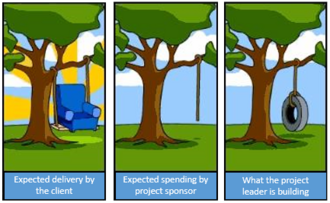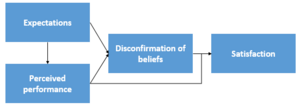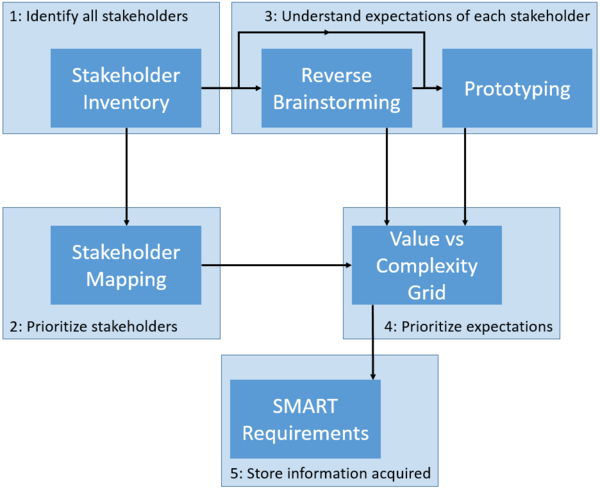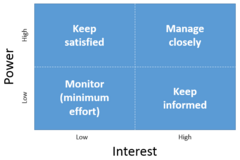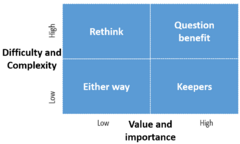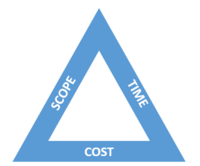Stakeholder Expectations Management
(→Other tools) |
|||
| Line 167: | Line 167: | ||
=Other tools= | =Other tools= | ||
| − | '''RACI Matrix: ''' The [[Responsibility Assignment Matrix (RACI Matrix)]] can clarify which stakeholders are connected and how are in a context of a specific task or process step. | + | *'''RACI Matrix: ''' The [[Responsibility Assignment Matrix (RACI Matrix)]] can clarify which stakeholders are connected and how are in a context of a specific task or process step. |
| + | *'''Risk Matrix?''' | ||
=Field of application toolbox= | =Field of application toolbox= | ||
Revision as of 09:31, 20 September 2016
*** work in progress - sources and quotations are still not mentioned in the article.*** Other possible title: Identify Stakeholder expectations: the base of project success
Stakeholder satisfaction is a main factor in a project success. Therefore, for a project manager is vital to have under control the satisfaction of the different stakeholders.
Stakeholder satisfaction is impacted by multiple factors during a project and it can be hard to directly manage it, but it can be improved by understanding, aligning and managing the stakeholders expectations. In fact, as illustrated by the expectancy confirmation model the stakeholder satisfaction is given by the discrepancy between the perceived performance of and the prior expectations about the outcomes.
Expectations usually differ between the different parties in a project and as the number of stakeholders arises aligning becomes more and more difficult.
The scope of this article is to present a set of tool to identify and manage stakeholder expectations. The tools are applicable both in the planning and execution phases and will be divided in proactive tools, to use in the planning phase and reactive tools, to support the project execution.
For each tool a brief description should provide the reader with enough information to apply it, and links for further information.
Contents |
Project Management and Stakeholder Management
Stakeholder Management is used to describe the process of identifying, assessing and building a relationship with the stakeholders. [How to do projects] Stakeholders are defined by the ISO 21500 standard as "a person, group or organisation that has interests in, or can affect, be affected by, or perceive itself to be affected by, any aspect of the project" [ISO21500. 2012. Guidance on Project Management. International Organization for Standardization].
Any project manager should identify and categorize all the key stakeholders defining which interests they have and how important they are for the completion of the project.
Most of the literature on project management recognizes the importance of stakeholders. As an example:
- PRINCE2[missing], states that in order to run a successful project, the project management team should have an effective strategy to manage communication flows to and from stakeholders. It also puts an emphasis on the importance of analysing the involved stakeholders with the purpose of being able to engage properly with them. Furthermore, it underlines the importance of stakeholder involvement, especially in projects that are not a part of a programme.
- The 5th edition of PMBOK from the Project Management Institute (PMI) has recognized the importance of stakeholder management and dedicated a knowledge area to it - Project Stakeholder Management. [7]
Different theories provide different criteria for project success; however recent literature is converging on defining the project success as a result of stakeholder satisfaction. The Project Management Triangle should be used when monitoring and controlling to check whether the project is deviating from its baseline. It is common to use scope, time, and costs in statistics to separate good projects and bad projects. But these are not the right indicators to evaluate if a project is a success or a failure. Business criteria should be taken into account, although success and failure is basically a matter of stakeholder appreciation. [1]
The importance of expectations in stakeholder satisfaction
From the previous section we understood how important ending the project with satisfied stakeholder is for the project success. In this section it will be presented a summary of what expectations are in the field of project management and what is the connection between expectations and satisfaction.
Expectation in general team is defined as "a belief that something will happen or is likely to happen".
In every project each stakeholder has different interests to participate or not, has different expectations as to the results of the project and has different definitions of when the project will be successful. Also the answer to the question "what's in it for me" is different for each stakeholder.
To better understand the concept of expectation and how it usually differs between stakeholders a practical example can help.[2]
Project: Refurbish homes and improve energy efficiency
- Central government is likely to perceive success in terms of reduced energy demand, improved energy security and reduced CO2 emissions. In some countries, refurbishment may also be a social policy measure to combat fuel poverty.
- Local government may be more interested in employment effects and keeping the building stock in good shape. In some regions, refurbishment may also be a social policy measure to combat fuel poverty.
- Participating companies may expect the project to create new markets and increased revenues.
- Residents (energy end-users) are most likely to value increased comfort, better living conditions and lower energy bills as important outcomes.
The PMI standard PMBOK guide include the topic of stakeholder expectations in the topics of " Identify Stakeholders" and "Manage Stakeholder Engagement" that is included in "Project Stakeholder Management". However, the standards don't include particular procedures and tools to discover and manage stakeholders expectations besides the stakeholder analysis. (Project Management: A guide to the Project Management Body of Knowledge (PMBOK guide) )
In general, finding literature focused on stakeholders expectation is hard, and the term, as in the PMBOK, is usually included in other tools and theories and doesn't stand by it self.
Expectation confirmation theory
Expectation confirmation [3] theory is a cognitive theory developed in the '70 by Richard L. Oliver. It was developed in a marketing literature but from there it was applied in multiple fields since its versatility and simplicity. The first application was to explain post-purchase or post-adoption satisfaction.
This effect is mediated through positive or negative dis-confirmation between expectations and performance. If a product outperforms expectations (positive dis-confirmation) post-purchase satisfaction will result. If a product falls short of expectations (negative dis-confirmation) the consumer is likely to be dissatisfied. [4]
Although this gap model of satisfaction was developed primarily within marketing to explain customer satisfaction, the relationships between buyer-seller is applicable to the relationship stakeholder-project manager (Taylor, 1993)
Toolboxs
Proactive toolbox
Ensuring stakeholder satisfaction is a process that starts before a project begins. The planning phase is the most crucial in understanding what value is expected by the various stakeholders and how to actually deliver it. In this phase, stakeholders expectations have to be aligned and, when this is not possible prioritized. However, stakeholders most of the time are not able to clearly explain their expectation. That is why in the toolbox two tools are dedicated to extract hidden desires and avoid communication misunderstanding. Once the expectations are clearly understood, the project manager should store the agreement in a written form to inform the project team on the goals and have a written proof in case that stakeholders change their mind. Indeed, once the project starts, modifications to satisfy stakeholders who were not included in the planning phases can cause big delays and cost increase.
Stakeholder inventory
The first step of managing the stakeholders expectation is to have the complete picture of who is a stakeholder in the project. The best method to create an exhaustive list is to hold a brainstorming workshop between the project team. The objective in this phase is to think creative to include every possible stakeholder. For normal projects, a brainstorm of 10-15 minutes should be sufficient.
Stakeholder mapping
From the stakeholder inventory is important to prioritize the stakeholders in base at their relationship with the project. For the purpose of this article, the theory background and detailed explanation on the different version of the tool will not be presented. The page Stakeholder Analysis explains in depth the concept and it's application.
The suggested version of the stakeholder mapping is the Power/Interest diagram. It is created by positioning the stakeholders in the different areas according to the estimated power, how much a stakeholder can affect the project, and interest, how much a stakeholder is involved in the project.
The x axis represents the interest, so the interest increases going from the left to the right. The y axis represents the power, so the power increases going from the bottom to the top.
Reverse brainstorming
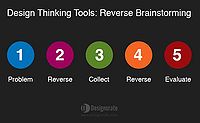
Trying to understand the stakeholder expectation in a project, a main issue can be found in the lack of a clear vision from the stakeholder of its desires. If asked with direct questions like "What do you expect this project to achieve?" or "How will this project help you?" stakeholders can have some difficulties in answering.
Reverse brainstorming is a 5 step progress that solves the problems of direct questioning by exploring multiple factors in reverse. This encourages more creative thoughts creating robust solutions.
The project manager should reverse the question he would need to understand the expectations. Examples could be "How can the project dissatisfy you?" and "How could we fail this project?"; by asking this kind of questions participation is encouraged through outside-the-box thinking.
From this first first phase, the negative ideas generated are reversed again to understand what are the positive expectation of the stakeholder. [5]
Prototyping
After some meeting and information exchange the project manager should have a preliminary idea of the expectations of the stakeholder. In case this expectations concern data and measurable results it is easy to communicate and agree with the stakeholder. However, many times the expectations regard subjective evaluation and even if the two parties agree it is not obvious that they are picturing the same result.
Therefore, before closing the confrontation with the stakeholder about their expectations is important to make sure that there during the process misunderstanding caused a distance between the actual expectation and what the project manager understood A prototype is an early sample, model, or release of a product built to test a concept or process or to act as a thing to be replicated or learned from. To make
Value vs complexity grid
From the brainstorming a number of requirements and needs will be collected. However, for a in a project satisfying every expectation impossible. The value vs complexity grid supports the decision making process of selecting the requirements to keep and the one to eliminate. It is based on two factors:
- Difficulty and complexity: it is related to technical considerations on how challenging the implementation will be, therefore there is a need of clear measurements for the criteria and support of technical team in order to help define the complexity of each requirement.
- Value and importance: it considers the functionality each requirement represents, dependencies other requirements have on it, value/benefits realized for the organization, and which stakeholders are associated with it.
SMART requirements agreement
After multiple iteration at this phase stakeholder expectations should be clear. However, it is necessary to formally store the information collected as a project requirement both to inform the project team avoiding internal misalignment and have a agreement proof in case a stakeholder changes its mind.
A requirement is nothing more than an expected outcome of the project. However the way the requirement is formulated should not leave space to interpretations. In the absence of facts and details, the stakeholder will interpret and make up assumptions. Moreover, everything should be stated in the requirements, if it is not stated, it is not committed to be completed.
To ensure a flawless requirements definition each requirement should be expressed through a SMART framework find another source
| Specific | Measurable | Attainable | Realistic | Time-bound | |
| Explanation | a good requirement is specific and not generic. It should not be open to mis-interpretation when read by others. | this answers whether you will be able to verify the completion of the project. You should avoid signing up for any requirement that cannot be verified as complete. | the requirement is physically able to be achieved given existing circumstances | answers whether the requirement is realistic to deliver when considering other constraints of the project and requirements | specify by when or how fast a requirement needs to be completed or executed |
Reactive toolbox
Even after a meticulous planning process to understand and accommodate stakeholder expectations, new and unexpected expectations could emerge. This new expectations could emerge from stakeholders that were not considered before or by changes in the environment.
The new expectations are are usually hidden within a request to change some parameter of the project.
Once the project manager comes across this requests, he/she has to act to understand what in the interest behind this new expectations. Indeed, as in the proactive toolbox, the direct request of changing something can not be the real need of who's asking. Negotiation techniques can support this process limiting the divergence from the original plan.
If there is no way to avoid changing plans, a delicate phase opens where the project manager has to understand how changing some parameters will influence the rest of the project and agree with the stakeholders a trade off between satisfying this new expectation and existing project requirements.
Issue log
When analyzing stakeholder expectation and issue represents the distance between the stakeholder expectation and the reality of the project. An issue log, in general project management term, contains a list of ongoing and closed issues of the project. While issue logs can be viewed as a way to track errors in the project, the role it plays often extends further. Issue logs can be used to order and organize the current issues by type and severity in order to prioritize issues associated with the current milestone or iteration.[6]
In this toolbox, the issue log is the backbone to keep track of the emerged problems, what expectation was besides them and how they where solved.
Integrative bargaining

When a new issue is identified, a project manager can't just approve every change and keep changing the scope of the project. Change in plan will cause distortions in cost and time of the project and could affect some other stakeholder expectation.
That is why is it important understand if the issue has to be resolved and what is the easiest way to solve it.
Integrative bargaining is a negotiation strategy in which parties collaborate to find the motivation behind the initial request and develop a "win-win" solution to their dispute. [7] In other words, the project manager has to understand what is the stakeholder expectation behind the request of a new project requirement and find another way to satisfy it.
Figure xx give and overview of the method and this short video visualize the benefits of Integrative bargaining as explained in the article.
Project Management Triangle
To support the negotiation the Project Management Triangle is a tool for the project manager to understand the effects of accepting to satisfy a new expectation. It is formed by its three dimensions, time, cost and scope, and a side of the triangle cannot be changed without affecting the others.
When a new expectation comes to the table, the project manager will now be able to analyze the feasibility of implementation and explain what other project requirements will be changed to accommodate the request. As an example, if a stakeholder request the project to finish before the set deadline the project manager will ask for a higher budget or to remove some features (scope).
Other tools
- RACI Matrix: The Responsibility Assignment Matrix (RACI Matrix) can clarify which stakeholders are connected and how are in a context of a specific task or process step.
- Risk Matrix?
Field of application toolbox
is it necessary?
Case Example
Template
Limitations
- Personal skills of PM are extremely important:
- Number of stakeholders: A critical limitation whit theories concerning stakeholders satisfaction is the relationship between the different stakeholder satisfactions. Indeed, some studies described that improve managerial performance in one stakeholder group can comes at the expense of performance for another group. However, more recent studies suggest that, within limits, managers are able to meet the performance expectations of three primary stakeholder groups simultaneously. The research paper,THE rules of stakeholder satisfaction (Kelly C. Strong et al 2001), presents a summary of this contrasting theories and a case study on the feasibility of satisfying three stakeholders groups simultaneously. However, even if this paper proves the possibility of satisfying different groups together, as the number of stakeholder increases satisfying all of them becomes harder and harder. That is why stakeholder mapping is of extreme importance, allowing the project manager to prioritize expectations.
